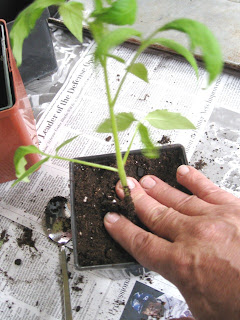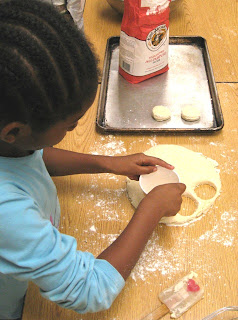
For the first time we can ever recall, we find ourselves in agreement with George Bush on a matter of urgent federal policy, namely, Bush's promise to veto Congress' most recent version of the Farm Bill.
Bush wants to
draw the line on the billions of dollars in subsidies Congress would like to continue doling out to the country's wealthiest farmers. We suspect what's really at work here is Bush trolling for money to fund his endless war in Iraq. Nevertheless, on the subject of cutting handouts to
agri-business, we concur.
While we're on the subject, lets address who it is we are talking about as the recipients of all these billions. Because it is not the farmers who are growing our cabbages and carrots and milking a few cows and raising a few pigs. In fact, there is no room in the federal subsidy scheme for that kind of farming. What we are really talking about are giant landowners who plant thousands of acres of specific crops such as corn or soybeans, wheat,, rice or cotton. They are part of a mutant agriculture that benefits most of all certain large corporations that take those crops and process them into feed, either to fatten animals in industrial meat centers or to fatten humans.
To call the lords of this mutant agriculture "farmers" is really a perversion of the term. Henceforth, we will refer to them as
agri-meisters.
Crop subsidies in the distant past were paid to farmers to prevent them from overproducing and thus support market prices for certain crops. But that all changed in the 1970s under Agriculture Secretary Earl
Butz, who turned the policy on its head and urged farmers to plant as much as possible. Of course that created a glut of things like corn and soybeans, which became ever so cheap to feed to cows and pigs and chickens in factory settings and emerged as the ingredients of choice in virtually every kind of processed food on the supermarket shelf.
After almost 40 years of
Butz's subsidies, we find that cheap food just makes animals and humans fat and unhealthy. But it sure makes lots of money for companies like
Cargill, Archer Daniels Midland, Monsanto and their ilk.
Anything that can be done to undo the federal subsidy system and return it to its original function of stabilizing prices is a good thing. Unfortunately, there are so many other vital programs wrapped up in the Farm Bill--child nutrition, school lunch, food aid, land conservation--that delaying passage of the bill only hurts those who are most needy.
Sounds like business as usual for our federal government, no?
*****
Here's a little pipe dream of ours: We remove our troops from the fiasco in Iraq and move them to Burma, where we take out the military junta that is preventing international food aid from reaching hundreds of thousands of cyclone victims.
While bodies are beginning to choke Burma's waterways, food shipments
have been seized. Resources were even being diverted from disaster relief to completing a voter referendum that would only tighten the junta's grip over the country. With no food or clean drinking water, thousands of Burmese face imminent death.
Has there ever been a better excuse to intervene?
*****
The cyclone in Burma drove the world's food crisis off the front page temporarily. But skyrocketing food prices continue to change the way people live around the globe.
In Cambodia, for instance, it is feared that thousands of destitute students
may stop going to school because in 30 days rice stocks will run out, meaning the end of free breakfasts.
The free breakfast program, started eight years ago in Cambodia's poorest schools, has been a huge hit, attracting many children who otherwise would not come to school. Teachers love it, because well-fed pupils are more attentive and eager to learn.
The imminent suspension of rice supplies is particularly paradoxical for the children who each day walk or ride their bicycles through miles of neatly delineated rice paddies on their way to school. Rice is plentiful in Cambodia, and the country has been a net exporter for the past decade. But it is becoming less and less affordable for the very people who grow it. In a 2006 survey, well before the spike in food prices, 22 percent of Cambodians in rural areas could not meet their own basic food needs.
Said one teacher: "Most of the students come to school for the breakfast."
*****
Escalating food prices are not just a problem for other countries. They are beginning to take a toll in the U.S. as well. Higher prices are
putting the squeeze on school lunches around the country, but especially in poorer school districts.
Schools participating in the National School Lunch Program are under a mandate to implement wellness programs that include reducing junk foods and provide healthier alternatives. But the healthier alternatives are becoming more and more expensive. School districts throughout the country are cutting back on fruits and vegetables as costs continue to soar.
Schools are finding they can't keep up with the program's nutritional guidelines. Often the healthier items aren't available, and more recently, to increase revenues, some schools are looking for ways to bring back hot ticket items—highly processed junk sold outside the
NSLP by private food and beverage companies.
New Jersey recently boosted by 40 cents the amount schools can charge for lunches. But even with the increase, food service directors are
adjusting menus to make sure they can make their budgets and still meet nutritional requirements.
School districts increasingly are turning to the federal food commodities program to reduce costs. State officials said about 20 to 25 percent of school cafeteria food is from the commodity program, and as demand increases, they worry there won't be as many commodities to distribute next year. Congress determines the funding entitlements, but food costs determine what that money buys.
"Even if the money stays the same, it's going to buy less food," said Phillip
Gambutti, chief of the state's Department of Agriculture food distribution program.
*****
With prices skyrocketing, more and more consumers are
dropping organics and going back to conventional foods to save a buck, according to Newsweek.
Newsweek reports that after about 20 years of steady sales growth in organics, shoppers are beginning to cut back. One survey found that only 27 percent of shoppers thought that organic food was worth the price, even though they agreed that it was probably healthier.
"I miss it terribly," said one Ohio woman who no longer shops at Whole Foods. "But let's face it, I just can't afford it anymore. Food everywhere is just so expensive lately. It's insane."
With corn, wheat and rice at record prices, there's even more financial incentive for farmers to grow conventionally. The rising price of organic grain is making it tough to feed all those free-range chickens and synthetic-hormone-free cows. Some organic farmers in the Northeast are even converting back to chemically enhanced crops to boost the bottom line.
"Organics is becoming the private school of food," says Ken Cook, president of the Environmental Working Group, which tracks organic-food production. "It's great if you can afford it. But pricing it out of people's reach is not a strategy for expansion."
Some organic growers are trying to hold the line on prices, but not necessarily
succeeding.
Stonyfield Farm, the huge organic dairy, has been hit by five cost increases from its milk producers in the past five years, but has raised its prices only twice.
"Despite the fact that we were once again hit with a $3 million milk cost increase this month, we do not feel that we can pass along another price increase," CEO Gary
Hirshberg told Newsweek. "Any further price increase will only hurt our mission to continue growing organic consumption."
This makes us ever so glad for our own kitchen garden....
*****
With all this talk about farmers cashing in on the spiking price of corn and other commodity crops, we sometimes forget that being a small-scale farmer can be tough. But here to remind us is Zoe Bradbury, who's been writing
"Diary of a Young Farmer" in
Edible Portland magazine.
In the latest installment, Bradbury describes how she has run out of cash after buying equipment, seeds and soil amendments. With no hope of any income until the first spring crops come in, she pays a visit to local USDA Farm Service Agency to apply for a loan.
First bad news: She can't get a loan for an irrigation system because her farm technically is on leased land. Second bad news: the loan she can receive would be based on the value of her crops calculated according to statewide commodity prices.
Unfortunately, those prices are nowhere near what she can actually charge for her designer vegetables, meaning she is only entitled to a pittance. But the only way she can support her argument is to show receipts for the last three years. This is her first year in business.
"I felt very small. I wondered where people like me were supposed to go if the United States Department of Agriculture
couldn’t help us," Bradbury writes. "A few days ago I got a one-year 0% interest credit card offer in the mail – and for the first time ever, I
didn’t toss it into the recycling bin."
*****
Finally, a ray of sunshine. We received an e-mail recently from
Ona Bacus, assistant coordinator of the Operation
Frontline program at the Capital Area
Foodbank here in the District of Columbia. We are delighted to hear that
Ona is widening the circle.
"As a coordinator of cooking and nutrition courses for low-income kids and adults in DC, I love reading about the classes you lead at your daughter’s school,"
Ona writes. "As a fellow local, 'happy chicken' foodie, I look forward to your weekly wrap ups and your reflections on current food policy issues. Your blog also introduced me to other food blogs I love now, and finally has inspired me to start my own! My blog will be focused on my work with Operation
Frontline and our cooking and nutrition classes around the city here in DC. It’s still in its beginning stages, but I hope you will check it out when you have a free moment:
http://www.ageneroushelping.blogspot.com/Notice the shout out to you in my first post!"
Thanks,
Ona. Congratulations on having someone making a video about Operation
Frontline and welcome to the
blogosphere.
Bon appetit....
 Our old electric lawn mower from Costco started to sound more like an egg beater so I kissed it goodbye and joined the ranks of modern push-reelers. It's a great feeling not to be trailing that power cord through the garden, knocking over my lettuces and onion plants. And now I don't have to answer any more questions about how much coal the local power plant is burning so I can cut my grass.
Our old electric lawn mower from Costco started to sound more like an egg beater so I kissed it goodbye and joined the ranks of modern push-reelers. It's a great feeling not to be trailing that power cord through the garden, knocking over my lettuces and onion plants. And now I don't have to answer any more questions about how much coal the local power plant is burning so I can cut my grass.


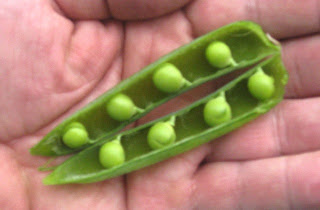

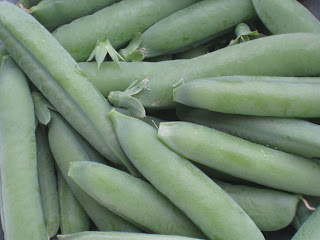
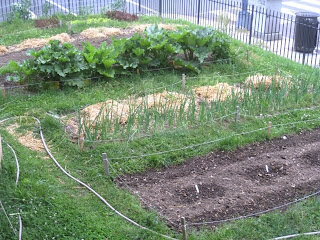











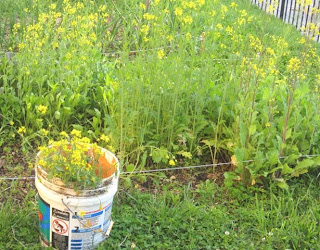




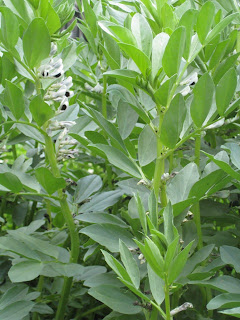


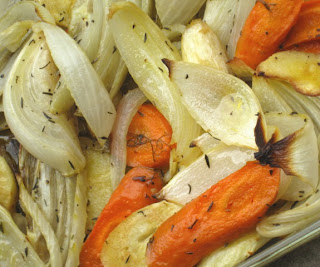


 I've always purchased my
I've always purchased my  I now find shelled
I now find shelled  Roast the garlic in its parchment-foil packet ahead of time in a 350-degree oven for one hour, then give it a chance to cool. When it comes time to make the vinaigrette, squeeze the garlic like toothpaste out of its paper skin into a mixing bowl. Kids love the smell of roasted garlic, but they weren't quite sure what to make of the squishy, caramelized puree that emerged.
Roast the garlic in its parchment-foil packet ahead of time in a 350-degree oven for one hour, then give it a chance to cool. When it comes time to make the vinaigrette, squeeze the garlic like toothpaste out of its paper skin into a mixing bowl. Kids love the smell of roasted garlic, but they weren't quite sure what to make of the squishy, caramelized puree that emerged.

 Some of the fava beans were in a prone position as well. Rhubarb stalks were snapped. A very tall garlic plant also lost its footing.
Some of the fava beans were in a prone position as well. Rhubarb stalks were snapped. A very tall garlic plant also lost its footing.
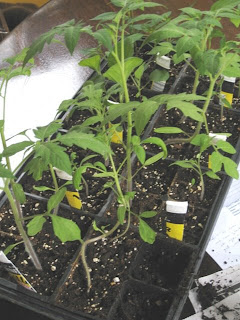

 Seeds started indoors should be moved to a sunny spot as soon as they sprout. It's hard to get them all the sunlight they crave. Often they grow long and lanky. If they get too "leggy," it's time to think of alternate light sources, or they could flop over and fail.
Seeds started indoors should be moved to a sunny spot as soon as they sprout. It's hard to get them all the sunlight they crave. Often they grow long and lanky. If they get too "leggy," it's time to think of alternate light sources, or they could flop over and fail.
